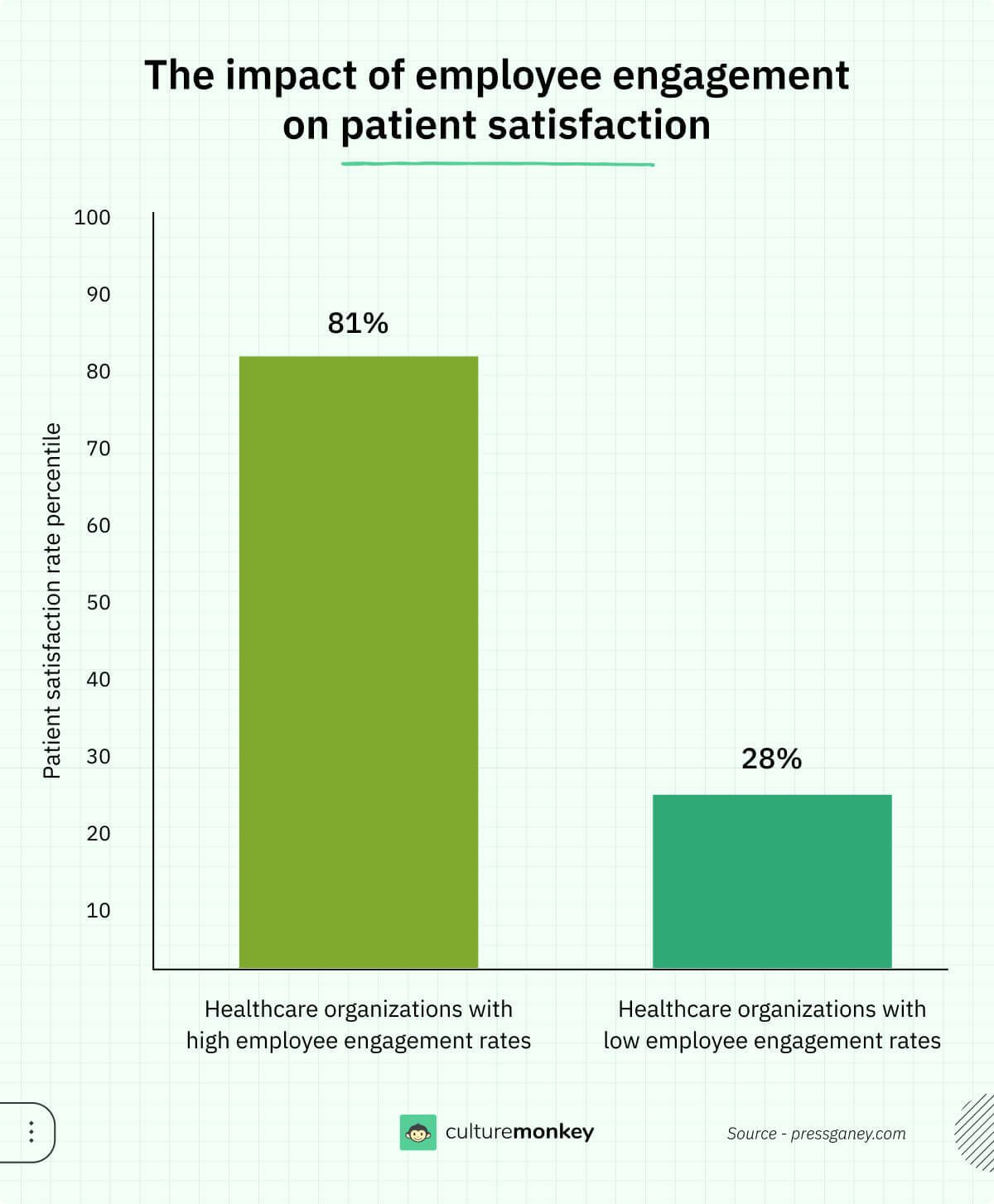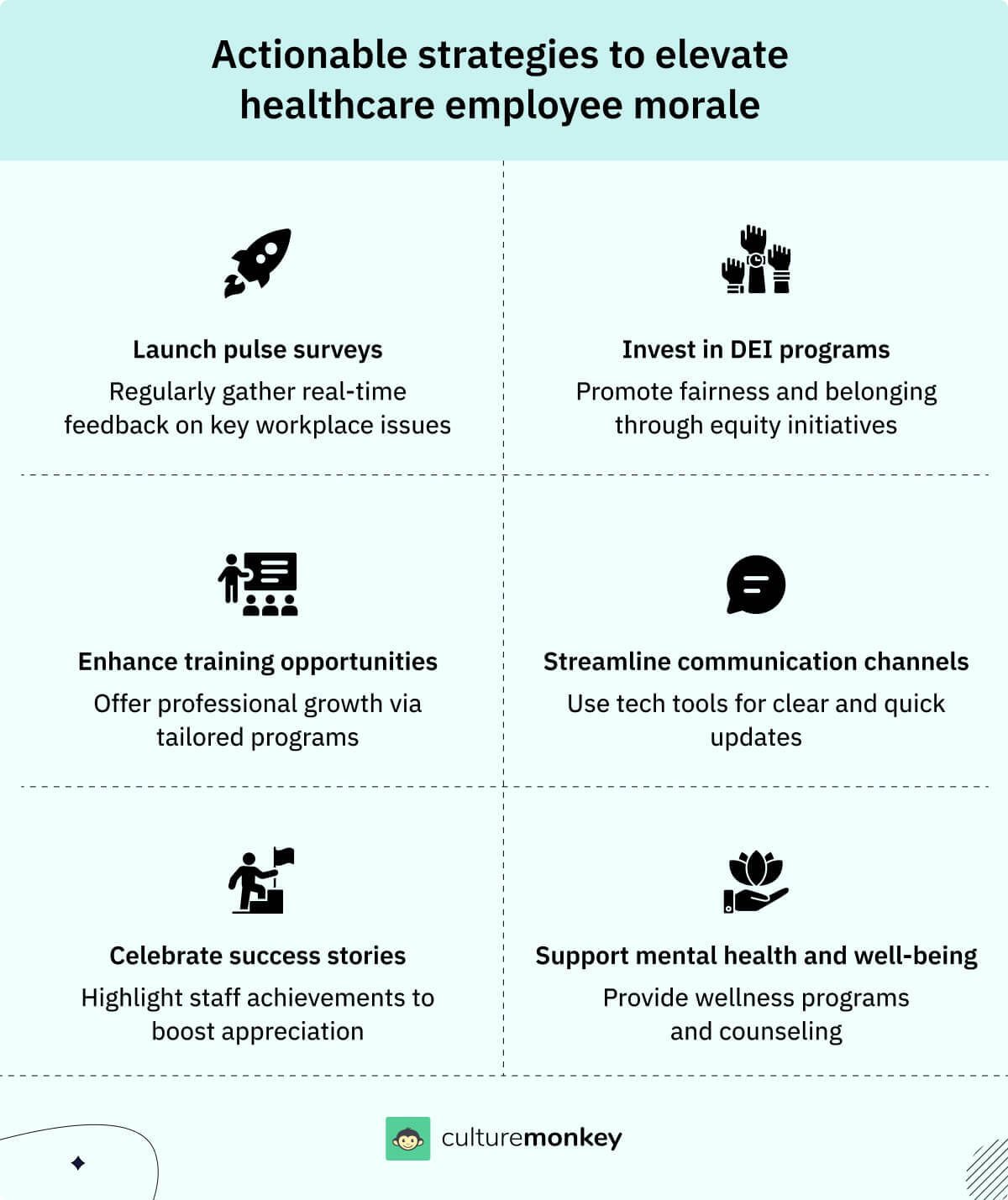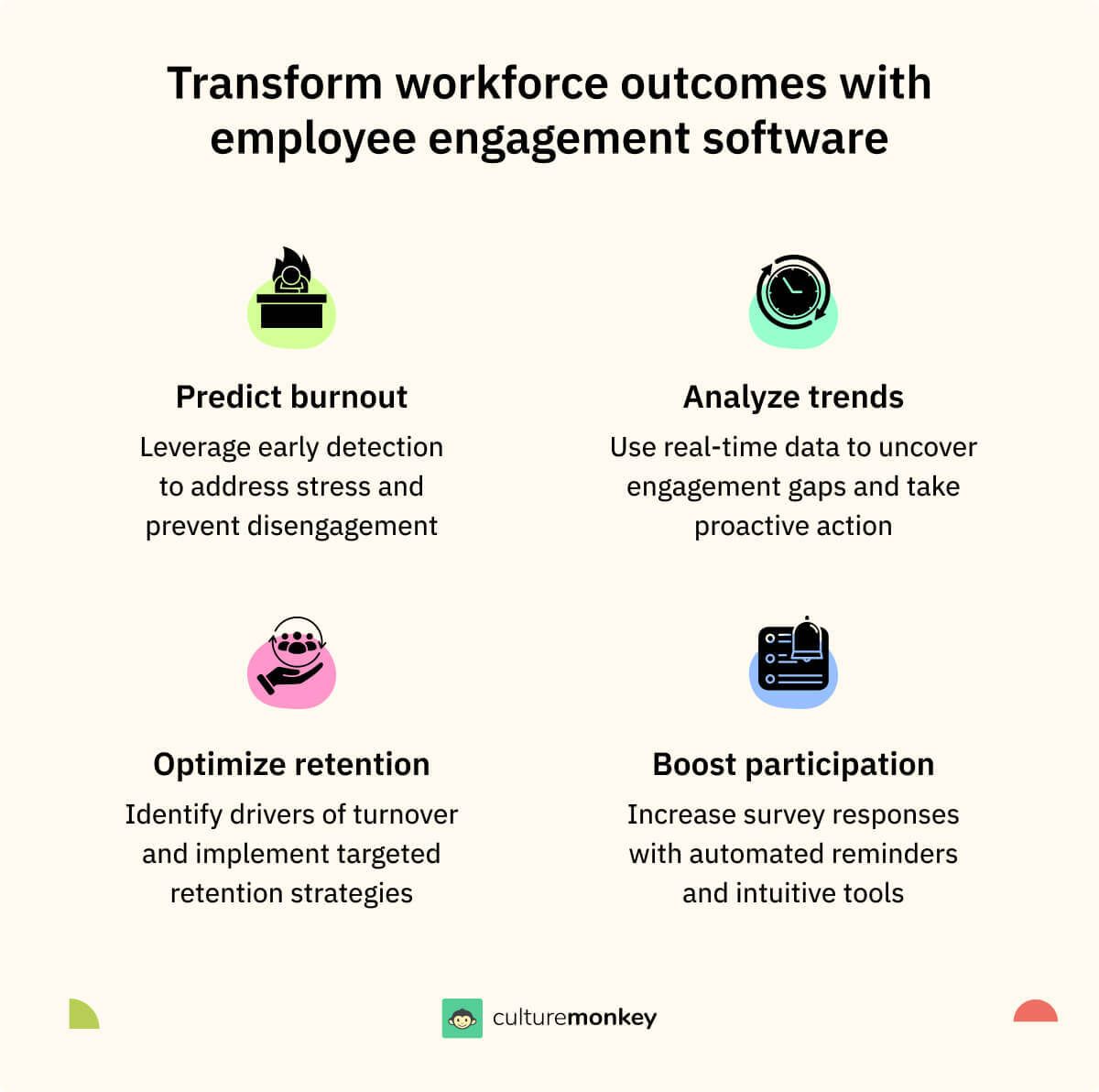What is a healthcare employee satisfaction survey: Benefits and top questions to ask in 2025

In today's demanding healthcare landscape, employee satisfaction is no longer a luxury, it's a necessity. Highly engaged and satisfied staff lead to better patient care, improved safety outcomes, and ultimately, a thriving healthcare organization.
But how do you gauge how your team is truly feeling? Enter the healthcare employee satisfaction survey.
This powerful tool goes beyond a simple thumbs-up or thumbs-down. It dives into the specific aspects that influence employee morale, engagement, and even their decision to stay.
By asking the right questions in 2025, you can uncover valuable insights into areas like workload, fringe benefits, work-life balance, professional development opportunities, and overall workplace environment.
In this article, We'll explore the undeniable benefits of conducting these surveys, from boosting retention to fostering a culture of open communication.
We'll also equip you with winning strategies for designing and deploying your own job satisfaction survey, ensuring you receive honest and actionable feedback.
Blog Highlights


- Why is employee satisfaction important in healthcare?
- Key components of a healthcare employee satisfaction survey
- 5 Healthcare employee satisfaction survey benefits
- 40 Healthcare employee satisfaction survey questions you should ask in 2025
- How to interpret and act on your healthcare employee satisfaction survey results?
What is staff satisfaction?

Staff satisfaction is a comprehensive measure of the overall contentment and fulfillment experienced by employees within their workplace. It encapsulates a multifaceted evaluation of various factors that collectively contribute to the well-being of the workforce.
This includes the quality of job conditions, the comfort and ambiance of the work environment, the adequacy of compensation, the nature of relationships with colleagues and superiors, and the availability of opportunities for professional growth.
The concept of staff satisfaction recognizes the interconnectedness of these elements and their impact on the overall employee experience. A positive staff satisfaction level indicates that employees find their work meaningful, feel valued, and have a sense of belonging within the organization.
On the contrary, low staff satisfaction may be indicative of issues such as poor working conditions, inadequate compensation, strained interpersonal relationships, or limited opportunities for career advancement.
Organizations often prioritize monitoring and enhancing staff satisfaction as it is closely linked to employee retention, productivity, and overall organizational success.
By fostering a positive work environment and addressing the diverse needs and concerns of their workforce, employers can contribute to higher levels of staff satisfaction and, in turn, create a more resilient and thriving workplace culture.
Why is employee satisfaction is important in the healthcare sector?

Employee satisfaction holds paramount significance in the healthcare sector due to its direct correlation with the quality of patient care, public health, and overall organizational effectiveness. In healthcare, the well-being and contentment of employees play a crucial role in ensuring optimal patient outcomes.
Firstly, satisfied healthcare professionals are more likely to exhibit higher levels of engagement and commitment to their work. This dedication translates into improved patient care as satisfied employees are better positioned to provide attentive and empathetic services.
High employee satisfaction often leads to lower turnover rates, reducing the disruptions caused by frequent staff changes and maintaining a consistent level of expertise within the healthcare team.
Moreover, the healthcare sector is inherently demanding, with employees frequently facing stressful and emotionally challenging situations.
Employee satisfaction initiatives, such as supportive work environments, fair compensation, and opportunities for professional growth, contribute to the overall well-being of healthcare staff, helping them cope with the pressures of their roles.
In a sector where teamwork is crucial, positive employee satisfaction fosters better collaboration among healthcare professionals, leading to more effective and coordinated patient care.
Ultimately, prioritizing employee satisfaction in healthcare is not only ethically sound but also pragmatically beneficial, promoting a virtuous cycle where contented staff members contribute to improved patient experiences and organizational success.



When healthcare organizations invest in their people, they create a virtuous cycle—higher retention, improved care, and a stronger organizational culture.
President
Healthcare Transformation (HCT)
What are the impacts of disengaged employees in healthcare?

Disengaged employees in the healthcare sector can have far-reaching and detrimental impacts on both the organization and the quality of patient care.
Some key consequences of disengagement include:
- Reduced patient satisfaction: Disengaged healthcare workers may exhibit lower levels of empathy and attentiveness, negatively impacting the patient experience. This can lead to lower patient satisfaction scores and potentially compromised healthcare outcomes which in turn can alert health policy makers.
- Increased medical errors: Disengaged employees are more prone to making mistakes, including medical errors. In the healthcare sector, errors can have severe consequences for patient safety, potentially leading to adverse events, complications, or even fatalities.
- Higher turnover rates: Disengaged employees are more likely to seek alternative employment opportunities. High turnover rates in healthcare can disrupt team dynamics, increase the workload for remaining staff, and result in a loss of institutional knowledge and experience.
- Decreased productivity: They are generally less motivated and productive. In healthcare, where efficiency and accuracy are critical, decreased productivity can lead to longer wait times, delayed treatments, and an overall reduction in the effectiveness of healthcare services.
- Negative impact on team dynamics: Such individuals may contribute to a negative work environment, affecting team morale and collaboration. This can lead to poor communication, decreased cooperation, and a breakdown in the interdisciplinary approach necessary for effective healthcare delivery.
- Impact on organizational reputation: Healthcare organizations with disengaged employees may experience a decline in their reputation. Negative reviews, both from patients and staff, can influence public perception and may deter prospective patients and skilled healthcare professionals from choosing the organization.
How do you measure staff satisfaction in healthcare?

Measuring staff satisfaction in healthcare involves employing various tools and methods to gather feedback on employees' and managers' experiences, perceptions, and levels of contentment.
Here are some common approaches to measuring staff satisfaction in the healthcare sector:
- Surveys and questionnaires: Distributing anonymous surveys and questionnaires allows healthcare organizations to collect quantitative and qualitative data on staff satisfaction. Questions may cover aspects such as job satisfaction, work environment, relationships with colleagues and superiors, compensation, and opportunities for professional development.
- One-on-one interviews: Personal interviews with individual employees offer a more in-depth exploration of their experiences. This method is particularly useful for understanding unique concerns, motivations, and suggestions for improvement.
- Employee feedback platforms: Utilizing digital platforms or intranet systems for continuous feedback allows staff to provide real-time input on various aspects of their work experience. This ongoing feedback loop enables organizations to address issues promptly and make data-driven improvements.
- Exit interviews: Conducting exit interviews with departing employees can reveal valuable insights into the reasons for their departure and their overall satisfaction with the organization. This information can help identify areas for improvement and enhance retention strategies.
- Performance metrics: Monitoring performance metrics, such as employee turnover rates, absenteeism, and productivity, can indirectly reflect staff satisfaction levels. Significant changes in these metrics may signal potential issues with overall employee well-being.
- Pulse surveys: Short, frequent pulse surveys conducted at regular intervals provide quick snapshots of staff satisfaction trends. These brief surveys can capture immediate feedback on specific issues and help monitor changes over time.
What are the various levels of hospital employee engagement?

Employee engagement in hospitals can be categorized into different levels, reflecting the varying degrees of commitment, motivation, and connection that individuals have with their work and the organization. While these levels are not universally standardized, they generally include:
1. Engaged employees
Engaged employees are highly committed, motivated, and passionate about their work. They are emotionally invested in the success of the hospital and its mission.
Engaged employees often go above and beyond their job responsibilities, contribute innovative ideas, and actively seek opportunities for professional development.
2. Satisfied employees
Satisfied employees may not exhibit the same level of emotional investment as engaged employees, but they are content with their work environment, job conditions, and overall experiences in the hospital.
They fulfill their roles effectively, maintain a positive attitude, and generally have a favorable perception of their workplace.
3. Neutral employees
Neutral employees may neither be highly engaged nor dissatisfied. They typically meet the basic requirements of their roles but may lack a strong emotional connection to their work or the organization.
Neutral employees may be less likely to actively contribute beyond their job responsibilities.
4. Dissatisfied employees
Dissatisfied employees experience discontentment occupational stress, frustration, or dissatisfaction with various aspects of their work.
This may stem from issues such as poor working conditions, inadequate compensation, lack of recognition, or limited opportunities for professional growth. Dissatisfied employees may exhibit lower levels of motivation and productivity.
5. Disengaged employees
Disengaged employees are characterized by a significant lack of commitment, motivation, and connection to their work and the organization. They may feel detached, demotivated, and disinterested in their roles.
Disengaged employees are at risk of reduced productivity, increased absenteeism, and potential negative impacts on the workplace culture.
What is a healthcare employee satisfaction survey: What are its objectives?

A healthcare employee satisfaction survey is a structured questionnaire designed to gather feedback from healthcare workers about their experiences, perceptions, and levels of contentment within the workplace.
The primary objectives of such surveys are to assess and understand the factors influencing employee satisfaction, identify areas for improvement, and inform strategic decisions aimed at enhancing both human service staff satisfaction and the overall work environment in healthcare settings.
Here are the key objectives of a healthcare employee satisfaction survey:
- Measure job satisfaction: Assess the overall satisfaction levels of healthcare employees regarding their jobs, roles, and responsibilities.
- Evaluate work environment: Understand the impact of the physical and psychosocial work environment on employee satisfaction, including factors such as safety, cleanliness, and interpersonal relationships.
- Assess compensation and benefits: Gather feedback on the fairness and adequacy of compensation, benefits, and reward systems provided to healthcare staff.
- Explore professional development opportunities: Identify the perceived opportunities for career advancement, training, and professional development within the organization.
- Examine leadership and management effectiveness: Evaluate the leadership and management practices within the healthcare facility, including communication, support, and decision-making processes.
- Understand team dynamics: Assess the effectiveness of teamwork, collaboration, and communication among healthcare teams, recognizing the importance of these factors in providing quality patient care.
- Identify recognition and appreciation: Gauge the extent to which employees feel recognized, appreciated, and valued for their contributions to patient care and the success of the organization.
Key components of an effective healthcare employee satisfaction survey
Specificity
Tailor questions to address the unique challenges faced by various roles in healthcare:
- For nurses: “Do you feel supported during high-stress situations, such as emergencies?”
- For administrative staff: “Do you have access to adequate tools to perform your duties efficiently?”
Customizing questions ensures responses are relevant and actionable, allowing HR teams to pinpoint role-specific concerns.
Structure
Balance quantitative and qualitative data collection for comprehensive insights:
- Use Likert scale questions to measure satisfaction levels (e.g., “Rate your satisfaction with work-life balance on a scale of 1-5”).
- Incorporate open-ended questions to capture nuanced feedback (e.g., “What improvements would you suggest to make your role more fulfilling?”).
Feedback loops
Design mechanisms to gather real-time feedback and track long-term trends:
- Implement pulse surveys to assess ongoing satisfaction in dynamic healthcare environments.
- Include follow-up surveys to measure the impact of changes implemented based on previous feedback.
5 Healthcare employee satisfaction survey benefits you should know

Healthcare employee satisfaction surveys offer various benefits to healthcare organizations, contributing to improved employee well-being, organizational success, and the overall quality of patient care.
Here are five key benefits associated with conducting healthcare employee satisfaction surveys:
1. Identifying areas for improvement
Employee satisfaction surveys help identify specific areas within the healthcare organization that may need improvement.
Whether it's through questions related to communication, work environment, leadership, or professional development opportunities, the survey results provide valuable insights into where changes or enhancements are needed.
2. Enhancing employee retention
Understanding the factors that contribute to employee satisfaction helps healthcare organizations implement strategies to retain talented and experienced staff.
By addressing concerns raised in the surveys, organizations can create a positive work environment, reduce turnover rates, and retain skilled healthcare professionals.
3. Boosting employee engagement
Employee engagement is crucial in healthcare, as engaged employees are more likely to provide high-quality patient care.
Healthcare employee satisfaction surveys measure engagement levels and help organizations implement initiatives to foster a sense of purpose, recognition, and connection among staff, ultimately improving overall engagement.

4. Improving patient care quality
Satisfied and engaged healthcare employees are more likely to deliver high-quality patient care.
The insights gained from employee satisfaction surveys can be used to enhance team dynamics, communication, and collaboration, leading to improved patient outcomes and a positive impact on the overall quality of healthcare services.
5. Informing strategic decision-making
The data collected from employee satisfaction surveys can inform strategic decision-making at the industrial and organizational psychology levels.
By understanding the needs and preferences of healthcare staff, leaders can make informed decisions on resource allocation, training programs, and organizational policies, fostering a culture that supports both employees and patients.
7 Healthcare employee satisfaction survey best practices

By following these best practices, healthcare organizations can maximize the effectiveness of employee satisfaction surveys, fostering a culture of continuous improvement and enhancing the overall work environment for healthcare professionals.
- Define clear objectives: Clearly outline the objectives of the survey, specifying what aspects of employee satisfaction you aim to measure and improve. This ensures that the survey is focused and relevant to organizational goals.
- Ensure anonymity and confidentiality: Assure employees that their responses will remain confidential and anonymous. This encourages honest feedback and allows employees to express their opinions without fear of reprisal, fostering a more open and accurate assessment.
- Use a mix of quantitative and qualitative questions: Combine quantitative (e.g., scaled ratings) and qualitative (e.g., open-ended questions) survey items. This provides a comprehensive understanding of employee satisfaction, allowing for both statistical analysis and nuanced insights into employees' experiences.
- Include benchmarking and comparative analysis: Incorporate benchmarking questions to compare results against industry standards or previous survey data. This allows healthcare organizations to identify areas of strength and weakness relative to peers and track improvements over time.
- Involve employees in survey design: Engage employees in the survey design process to ensure that questions are relevant and reflective of their experiences. Involving employees in the development of the survey can increase buy-in and the likelihood of obtaining valuable, actionable feedback.
- Provide timely feedback and action plans: Communicate survey results promptly and transparently to employees. Develop action plans based on the feedback received, highlighting areas for improvement and outlining specific steps the organization will take to address identified issues. This demonstrates a commitment to positive change.
- Conduct regular, ongoing surveys: Implement regular surveys rather than one-time assessments. Ongoing surveys help organizations track changes in employee satisfaction over time, allowing for continuous improvement efforts and ensuring that interventions are effective.
How to ensure inclusivity in healthcare employee satisfaction surveys
Inclusivity is critical to gathering honest and representative feedback in diverse healthcare settings. Here’s how to create an inclusive survey:
1. Role-specific insights
Address the unique challenges faced by different roles:
- Frontline workers: Include questions about safety, workload, and emotional well-being.
- Support staff: Focus on job security, recognition, and access to resources.
- Leadership: Explore feedback on decision-making processes and communication.
2. Accessibility
Make surveys easy to access and complete:
- Mobile-friendly formats ensure participation from staff who are always on the move.
- Provide multilingual options to cater to non-native speakers.
- Ensure anonymity to encourage candid responses without fear of repercussions.
3. Cultural sensitivity
Respect diverse cultural backgrounds by framing questions carefully:
- Avoid biased language or assumptions. For instance, instead of asking “Do you feel included in team social events?” use “Do you feel included in workplace activities?”
4. Equity
Capture diverse perspectives by reaching out to underrepresented groups:
- Schedule surveys to accommodate varying shifts, ensuring participation from night and weekend staff.
- Use stratified sampling techniques to ensure all departments and demographics are proportionately represented.
40 Healthcare employee satisfaction survey questions you should ask in 2025

Below are 40 healthcare employee satisfaction survey questions covering various aspects of the work environment and employee experience at healthcare providers.
These questions are designed to provide a comprehensive understanding of healthcare professionals' satisfaction and identify areas for improvement:
- On a scale of 1 to 5, how satisfied are you with your current job?
- How satisfied are you with the physical work environment, such as cleanliness and safety measures?
- Do you feel that your workload is manageable within your current role?
- How well do you think the organization supports diversity and inclusion in the workplace?
- Are you satisfied with the transparency and fairness of the organization’s promotion policies?
- How satisfied are you with the opportunities to provide feedback to leadership?
- Would you recommend this healthcare facility as a great place to work to others?
- How would you rate the effectiveness of leadership within your healthcare facility?
- Do you feel your opinions and ideas are valued by your immediate supervisor?
- How well do leaders communicate the organization's goals and initiatives?
- Are you satisfied with the opportunities to provide feedback to leadership?
- Do you feel you are adequately informed about changes within the organization?
- Are you provided with the necessary resources and tools to perform your job effectively?
- How satisfied are you with the technology and tools provided to perform your job?
- How well does the organization support employee well-being and stress management?
- Are there resources available to help you cope with work-related stress?
- How often do you feel stressed or overwhelmed at work?
- How well does the organization accommodate special needs or requests, such as flexible hours or health accommodations?
- To what extent do you feel supported by your colleagues in your daily work?
- How effective is the communication within your healthcare team?
- Do you believe there are adequate opportunities for teamwork and collaboration?
- How effective is the organization at recognizing and rewarding teamwork?
- Are you satisfied with the opportunities for professional development within the organization?
- How well does the organization support your career advancement goals?
- Are you provided with ongoing training to enhance your skills and knowledge?
- Do you feel the organization provides adequate training on patient safety protocols?
- How often do you receive recognition for your contributions to patient care?
- Are there formal mechanisms in place for acknowledging and appreciating your work?
- Do you feel valued and appreciated by the organization as a healthcare professional?
- Do you feel your compensation reflects the level of effort you put into your work?
- How satisfied are you with your current compensation and benefits package?
- Are there opportunities for additional recognition and rewards for outstanding performance?
- How well does your work schedule accommodate a healthy work-life balance?
- Are you able to take advantage of flexible work arrangements if needed?
- Do you feel you have enough time for personal and family activities outside of work?
- Do you feel the organization takes proactive steps to prevent workplace harassment or bullying?
- On a scale of 1 to 10, how engaged do you feel in your current role and within the organization?
- Do you feel that your contributions directly impact the success of the organization?
- What specific changes or improvements would you suggest to enhance employee satisfaction?
- What additional support or resources would help you perform your job better?

Unlock team potential,
achieve better results
Boost morale and retention with these essential
survey questions for your healthcare workforce.
How to improve employee engagement in healthcare: 6 Top strategies

Improving employee engagement in the healthcare sector is paramount for cultivating a positive workplace culture and ultimately enhancing patient care. A multifaceted approach is essential, encompassing various strategies to address the unique challenges and demands faced by healthcare professionals.
One crucial element is the commitment of leadership to fostering a positive work culture. Leaders must exemplify desired behaviors, actively participate in initiatives to improve the work environment and maintain transparent and open communication channels.
Prioritizing employee well-being is another key strategy. Implementing wellness programs that address both physical and mental health, along with offering confidential counseling services through Employee Assistance Programs (EAPs), demonstrates a commitment to the holistic well-being of healthcare professionals.
Supporting ongoing training and development opportunities is crucial for providing a pathway for professional growth. By investing in the skills and career advancement of employees, healthcare organizations not only enhance job satisfaction but also contribute to a more skilled and motivated workforce.
Recognizing and appreciating the contributions of healthcare professionals is essential. Establishing regular recognition programs and promoting a culture of peer acknowledgment fosters positivity and motivation. Team collaboration plays a pivotal role in improving engagement.
Organizing team-building activities and emphasizing an interdisciplinary approach to patient care enhances communication, collaboration, and overall job satisfaction.

Additionally, seeking employee input and involvement is a fundamental strategy. Establishing regular feedback mechanisms, such as surveys and focus groups, ensures that healthcare professionals' opinions are considered in decision-making processes.
Involving employees in relevant decision-making fosters a sense of ownership and empowerment.
How to interpret and act on your healthcare employee satisfaction survey results?

Comprehending and effectively translating healthcare employee satisfaction survey results into actionable plans is crucial for organizational improvement. Here's a step-by-step guide on how to do this:
Analyze survey data
Begin a systematic review by conducting a thorough quantitative and statistical analyses of the survey data. Use statistical tools to identify patterns, trends, and areas of concern or strength. Examine overall satisfaction scores, demographic variations, and correlations between different survey items.
Simultaneously, analyze qualitative responses from open-ended questions to gain deeper insights into specific issues, concerns, or suggestions raised by healthcare employees.
Identify key themes and prioritize issues
Identify recurring themes and prioritize issues based on their impact and frequency.
Recognize both positive aspects that should be maintained or expanded upon and negative aspects that require attention. This step helps in focusing efforts on the most critical areas for improvement.
Benchmark against previous surveys and industry standards
Compare current survey results with data from previous surveys to assess trends and improvements. Benchmark against industry standards or best practices to gain a broader perspective on where the organization stands relative to its peers.
Engage stakeholders and leadership
Present survey findings to relevant stakeholders and leadership. Discuss the key themes, areas for improvement, and opportunities for enhancing employee satisfaction. Encourage an open dialogue to gather additional insights and perspectives.
Develop action plans
Based on the identified themes and priorities, collaboratively develop actionable and measurable plans for improvement. Clearly outline specific steps, responsibilities, timelines, and performance indicators for each action item.
Communicate findings and action plans to employees
Transparently communicate the survey findings, priorities, and action plans to all healthcare employees. Emphasize the organization's commitment to addressing their concerns and improving the work environment.
Also, provide regular updates on the progress of action plans to maintain transparency and keep employees informed.
Implement interventions and monitor progress
Implement the identified interventions and closely monitor their impact. Evaluate the effectiveness of the action plans through quantitative and qualitative measures. Adjust strategies as needed based on ongoing feedback and results.
Encourage employee involvement
Involve employees in the implementation process by seeking their input and feedback. Encourage a participatory approach, where healthcare professionals actively contribute to the solutions and improvements.
Conduct follow-up surveys
Schedule follow-up surveys to assess the impact of implemented interventions. Use these surveys to gauge changes in employee satisfaction levels, identify new challenges, and inform continuous improvement efforts.
Top 5 employee survey tools to conduct your healthcare employee satisfaction survey in 2025 (Free & Paid)
Here are five tools that are effective employee survey tools:
1. CultureMonkey (Paid)
CultureMonkey is an innovative employee engagement survey tool that revolutionizes the way companies conduct employee satisfaction surveys.
With its user-friendly platform and comprehensive features, CultureMonkey empowers organizations to gather valuable feedback from employees, analyze data effectively, and drive meaningful improvements in the workplace.
One of the key features of CultureMonkey is its ability to streamline the process of conducting employee satisfaction surveys. The platform offers customizable survey templates that cover various aspects of the employee experience, such as job satisfaction, communication, leadership, and organizational culture.
These templates can be tailored to suit the specific needs and objectives of each organization, ensuring that the survey questions are relevant and impactful.
Employee satisfaction surveys play a crucial role in helping companies understand the needs and preferences of their workforce. By regularly gathering feedback from employees, organizations can identify areas where they are excelling and areas where there is room for improvement.
This insight enables companies to make strategic decisions that prioritize employee satisfaction and well-being, leading to higher morale, increased productivity, and improved retention rates.
Moreover, satisfaction surveys help companies foster a culture of open communication and transparency.
By giving employees, a voice and actively listening to their feedback, organizations demonstrate that they value and prioritize employee input. This fosters trust and collaboration within the workplace, creating a positive and supportive environment where employees feel heard, valued, and engaged.
Learn more about CultureMonkey
2. Qualtrics (Free with limitations)
Qualtrics stands out as a comprehensive employee experience management platform with advanced tools for survey creation and distribution.
It boasts robust analytics and reporting capabilities, making it suitable for organizations seeking a holistic approach to measuring employee feedback and engagement levels. Pricing is structured based on organizational size and specific needs.
Learn more about Qualtrics
3. Glint (Paid)
Glint, now a part of Microsoft, specializes in real-time employee engagement surveys. It provides advanced analytics for actionable insights and trend analysis, along with continuous listening and pulse surveys for ongoing assessment.
Glint also offers collaboration and action planning tools to facilitate positive changes within the organization. Pricing varies according to organizational requirements and size.
Learn more about Glint
4. TINYpulse (Paid)
TINYpulse focuses on anonymous employee feedback and pulse surveys, providing tools for recognition and appreciation to boost morale.
With actionable insights and analytics for monitoring engagement levels, TINYpulse offers a comprehensive approach to assessing and enhancing employee satisfaction. The tool's pricing plans are structured based on the number of users and organizational needs.
Learn more about TINYpulse
5. 15Five (Paid)
15Five is a performance management and employee engagement platform that offers robust tools for continuous feedback, goal alignment, and engagement surveys.
Its intuitive interface allows organizations to create customized surveys and leverage advanced analytics for actionable insights. With features like 1-on-1 meeting tools, performance reviews, and real-time recognition, 15Five helps organizations foster a culture of growth and collaboration. Pricing is tailored to organizational size and specific feature requirements.
Learn more about 15Five
What are the top trends in healthcare employee satisfaction for 2025?
1. AI-powered analytics
Artificial intelligence is revolutionizing survey analysis by:
- Identifying burnout risks: AI detects patterns in responses to predict high-stress zones.
- Optimizing interventions: Automated insights suggest actionable next steps based on data trends.
AI allows HR leaders to act preemptively, improving workforce well-being.
2. Continuous listening platforms
Organizations are replacing static annual surveys with dynamic, pulse feedback loops:
- Real-time feedback ensures immediate action on pressing concerns.
- Frequent check-ins foster a culture of ongoing communication and improvement.
This approach ensures employee voices are heard consistently, not just once a year.

3. DEI-centric surveys
Diversity, Equity, and Inclusion (DEI) metrics are now integral to satisfaction surveys:
- Include questions assessing employees’ sense of belonging and fairness.
- Use results to identify gaps in representation or equity within the organization.
DEI-focused surveys strengthen organizational culture by addressing systemic issues.
4. Mobile and gamified surveys
Mobile-first designs and gamification are boosting participation rates:
- Mobile accessibility ensures staff can respond during breaks or on the go.
- Gamification elements like progress bars and rewards make surveys more engaging.
This trend ensures higher completion rates and more reliable data.
5. Integration with employee experience platforms
Satisfaction surveys are now part of holistic platforms that track:
- Employee feedback alongside performance data.
- Trends over time, providing a 360-degree view of employee engagement.
Integrated platforms enable HR teams to make data-driven decisions with a complete picture of workforce satisfaction.
Conclusion
Effectively measuring and enhancing employee satisfaction in the healthcare sector requires thoughtful consideration of employee engagement survey tools and strategic approaches.
Recognizing the pivotal role of engaged and satisfied healthcare professionals in delivering quality patient care, organizations should leverage innovative survey tools like CultureMonkey.
By prioritizing a positive work culture, supporting employee well-being, providing opportunities for professional growth, recognizing contributions, promoting team collaboration, and seeking employee input, healthcare organizations can create environments that foster engagement and, ultimately, contribute to improved patient outcomes and organizational success.
Regularly assessing and adapting these strategies will be essential to meet the evolving needs of healthcare professionals and the dynamic nature of the industry.
Summary
Employee satisfaction is a cornerstone of success in the healthcare sector, directly impacting patient care, staff retention, and organizational effectiveness. This blog explores the importance of employee satisfaction surveys, detailing their benefits, best practices, and strategies to boost engagement and inclusivity. By leveraging actionable insights from surveys, healthcare organizations can foster a positive work culture, enhance team collaboration, and deliver improved patient outcomes.
FAQs
1. What is the job satisfaction scale for healthcare workers?
A job satisfaction scale measures how fulfilled employees feel in their roles. Typically, it ranges from 1 to 5 or 1 to 10, assessing factors like workload, recognition, work-life balance, and growth opportunities. In healthcare, customizing scales to reflect the industry's unique challenges ensures actionable insights to improve retention and patient care outcomes.
2. What is an acceptable employee satisfaction rate?
An acceptable employee satisfaction rate varies by industry, but in healthcare, it generally ranges between 70-80%. High rates indicate a well-supported workforce, crucial for maintaining quality patient care. Lower rates can signal burnout or systemic issues, prompting immediate interventions to improve morale, engagement, and organizational culture for optimal outcomes.
3. How often should I conduct satisfaction surveys in the healthcare industry?
Healthcare organizations should conduct annual satisfaction surveys complemented by quarterly pulse surveys. This approach captures real-time feedback while tracking long-term trends, ensuring timely interventions. Frequent surveys are vital in healthcare’s fast-paced environment, enabling organizations to identify and address issues like burnout, workload imbalances, or communication gaps proactively.
4. How can I compare my hospital's survey results with industry benchmarks?
Use benchmarking tools like CultureMonkey or Qualtrics to compare your survey results against industry standards. Focus on key metrics like engagement, turnover, and well-being. Benchmarking reveals gaps, identifies strengths, and helps set realistic goals for improvement, ensuring your organization remains competitive and aligned with best practices in healthcare.
5. What are the best times to conduct employee satisfaction surveys in healthcare?
Conduct surveys during stable operational periods, avoiding peak seasons like flu outbreaks or major staffing changes. For healthcare, post-performance reviews or at the start of a fiscal year work best. Timing ensures employees are focused and less stressed, leading to more accurate and actionable feedback that informs meaningful improvements.




